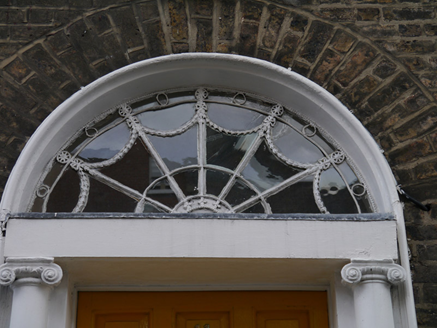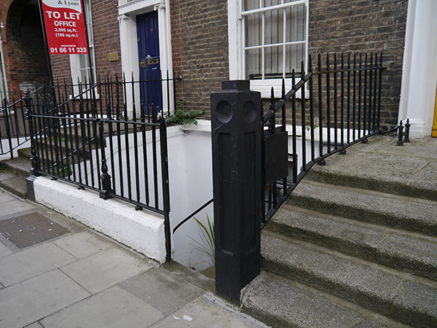Survey Data
Reg No
50930240
Rating
Regional
Categories of Special Interest
Architectural, Artistic
Original Use
House
In Use As
Office
Date
1820 - 1830
Coordinates
316328, 232976
Date Recorded
16/09/2015
Date Updated
--/--/--
Description
Terraced two-bay four-storey over basement former townhouse, built c. 1825, with two-storey return to rear (south). Now in use as offices. M-profiled slate roof, concealed by brick parapet with granite coping, parapet gutters, replacement chimneystacks to east and west party walls, red brick to east and rendered to west, with replacement clay pots. Brown-brick walling laid in Flemish bond, buff brick to rear elevation, rendered walling to basement beneath granite stringcourse. Square-headed window openings with brick voussoirs, patent reveals and granite sills; single round-headed opening to second floor rear. Splayed reveal to ground floor of north elevation and iron guard rails affixed to first floor. Largely replacement six-over-six sliding timber sashes with horns; six-over-six original to second floor, uPVC casements to third floor and recent timber casement to basement. Replacement eight-over-eight sash to second floor rear. Round-headed door opening to principal elevation (north) with brick voussoirs, moulded reveals and Ionic doorcase comprising engaged Ionic columns supporting plain lead-capped frieze surmounted by ornate fanlight over six-panelled timber door. Granite entrance platform with cast-iron boot scraper, approached by five granite steps, flanked by cast-iron railings over masonry plinth with panelled masonry corner posts, enclosing basement area. Coal-hole cover to pavement. Enclosed yard to rear, bound by return and rendered wall.
Appraisal
Pembroke Street Upper is characterised by well-proportioned late-Georgian brick terraces which display restrained detailing and classically-styled doorcases. Despite the loss of some historic fabric, this townhouse, forming part of a terrace of similar townhouses, with its Ionic doorcase and fanlight, makes a positive contribution to the streetscape of Pembroke Street Upper and to the historic Georgian core of south Dublin.

















